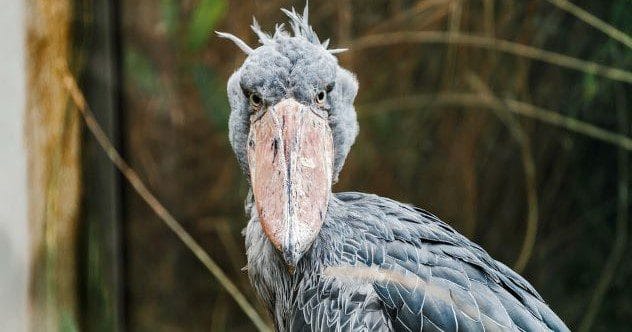As humans, we may not give a second thought to our bodily waste after the digestive process is complete, but in the animal kingdom, waste can be a valuable resource. Some animals have adapted to use their own waste, or the waste of other organisms, in truly remarkable ways. From regulating body temperature to defending against predators and ensuring food supply, here are ten amazing animals that use waste to not only survive but to thrive in their habitats.
10 Shoebill
The shoebill (Balaeniceps rex) is a large, prehistoric-looking water bird found in the marshes and swamps of East Africa. Standing between 3.5 and 5 feet tall, the shoebill is known for its distinctive, foot-long bill that resembles a Dutch clog. This specialized bill allows it to easily grab and consume large prey such as lungfish, eels, and even baby crocodiles.
But here’s the fascinating part: to survive the warm African temperatures, shoebills poop on their own legs. Because bird feces is mostly liquid, as they excrete on their legs, the waste cools down the warm blood flowing through their legs. This allows cooler blood to circulate through their body, helping them regulate their temperature in the heat.[1]
9 Cassowary
Cassowaries are large, flightless birds native to the tropical forests and wetlands of Northern Australia, New Guinea, and surrounding islands. Often called the most dangerous bird in the world due to their dagger-like claws, these birds also play a vital role in their ecosystem.
Cassowaries have a short digestive tract and unusual stomach enzymes, allowing them to consume toxic fruits and seeds without harm. Because much of what they eat is only partially digested, and the seeds are passed into their feces, cassowaries are essential to their environment. Known as rainforest gardeners, they consume fruit from 238 different plant species, and the seeds are then fertilized and distributed over large areas throughout the rainforest. Cassowaries and their tree-growing scat play a crucial role in maintaining the diversity of their habitat.[2]
8 Pika
Pikas are small mammals that resemble a cross between a guinea pig and a rabbit. Living in the mountains of North America and Asia, one species, the plateau pika, resides on the Qinghai-Tibetan plateau in northwestern China, where winter temperatures can plummet to -20°F (-29°C).
To survive these extreme conditions, the plateau pika slows down its metabolism and consumes yak droppings to obtain much-needed nutrients. During the cold winter environment, plants shrivel, and grasses become brittle, leaving the pika without a traditional food source. Without yak droppings, the plateau pika would have no other way to make it through the winter months.[3]
7 Tortoise Beetle
Tortoise beetles are small, turtle-like insects measuring less than 0.5 inches in length. These beetles have a domed carapace similar to a turtle’s shell, and some species can even change their carapace color within seconds.
The larvae of tortoise beetles use a bizarre camouflage technique to protect themselves from enemies, creating an “umbrella” of their fecal matter (or frass) combined with caste exoskeletons. The larva uses a “fecal fork” to attach its feces, creating a protective parasol. This fecal shield serves as camouflage and a smelly barrier to deter potential predators. The larva can even reposition the fecal umbrella as needed to face a predator. These poo umbrellas provide a much-needed form of protection for their survival.[4]
6 Egyptian Vulture
Egyptian vultures, found in southern Europe, the Middle East, Central Asia, and parts of North Africa, are known for using tools like pebbles to crack open ostrich eggs. These birds were considered sacred by the ancient Egyptians and are a symbol of the goddess Isis.
Egyptian vultures have striking white and black feathers with a bright yellow face. This bright yellow color is a result of their diet. Because they feed on rotten flesh and garbage, they don’t obtain enough carotenoids through their traditional food source. Therefore, they eat cow, sheep, and goat droppings to obtain these nutrients and ensure their bright yellow complexion, which impresses mates and intimidates competitors.[5]
5 Opossum
Opossums are marsupials native to North America, known for their gray or whitish fur, pointed snout, and long, hairless tail. They have a wide variety of food sources, including fruit, snakes, and even venomous snakes, to which they are immune.
With a short lifespan and threats from predators, opossums have developed a clever way to protect themselves through a behavior commonly referred to as “playing possum.” This involves keeling over, playing dead, defecating, and releasing a foul green slime from their anal glands. This makes any potential predator assume the opossum is dead and lose interest.[6]
4 Baleen Whales
Baleen whales, including humpback, fin, and blue whales, have specialized bristle-like structures in their mouths called baleen, which they use to filter krill from the water. An individual blue whale can consume an average of 16 tons of food each day, resulting in huge amounts of excrement flowing back into the water.
Whale feces is some of the most iron-rich material in the ocean. As whales eat, digest, and dispose of krill through their feces, it is sent to the surface of the water, where photosynthesis allows tiny phytoplankton to grow, which krill then feed on. Therefore, whale waste fertilizes the ocean, aiding in the regrowth of phytoplankton, their primary food source.[7]
3 Koala
Koalas reside in the eucalyptus forests of southeastern and eastern Australia and consume more than 1 pound of eucalyptus leaves each day. While eucalyptus leaves contain toxic compounds, koalas have a specialized digestive system that allows them to break down these toxic oils.
Koalas aren’t born with the bacteria needed to process their eucalyptus diet. As infants, they must obtain it from their mother. To do so, baby koalas eat a specially made form of their mother’s poop called pap. This allows them to gain the essential gut bacteria needed for consuming eucalyptus, without which they could not survive.[8]
2 Mistletoebird
The mistletoebird, found throughout mainland Australia, feeds primarily on mistletoe berries. Lacking a gizzard for grinding food, the mistletoe bird has a specialized digestive system that allows mistletoe seeds to pass through its digestive tract unharmed within approximately 25 minutes of consumption. When excreted, the seeds are covered in a sticky coating.
To clean the seed off its rear, the mistletoe bird rubs itself against tree branches, a practice known as the waggle-dance. This leaves the seeds safely behind on the mistletoe branches, ready for germination. Since mistletoe is a parasitic plant that relies on a host for germination, the mistletoe bird’s behavior ensures a replenishing food supply for the species.[9]
1 Vampire Squid
The vampire squid, scientifically named Vampyroteuthis infernalis, lives 2,000 to 3,000 feet below the surface of temperate and tropical waters in the Pacific, Atlantic, and Indian Oceans. These deep waters have low oxygen concentration and limited prey, but the vampire squid has adapted to survive by acting as “the garbage disposal of the ocean.”
The vampire squid consumes “marine snow,” a combination of dead animal material, feces, and mucus. As the only living cephalopod species known to be a scavenger, the vampire squid cleans up the ocean’s waste while providing itself with a food source to thrive in a difficult environment.[10]
From self-cooling shoebills to rainforest-gardening cassowaries and waste-eating vampire squids, the animal kingdom is full of incredible adaptations that allow animals to thrive in unique and challenging environments. Who knew waste could be so vital for survival?
What do you think about these animals? Let us know in the comment section.










